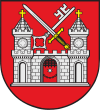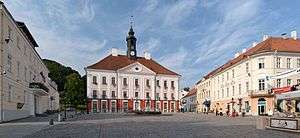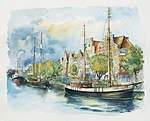Tartu
| Tartu | |||
|---|---|---|---|
| City | |||
|
Tartu linn City of Tartu | |||
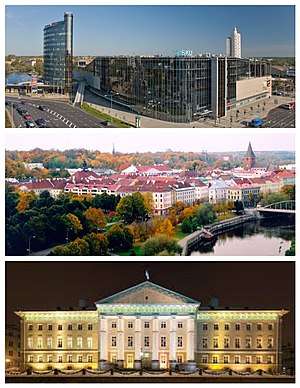 From top to bottom: City Centre, Old Town of Tartu, University of Tartu | |||
| |||
| Motto(s): Heade mõtete linn ("City of good thoughts") | |||
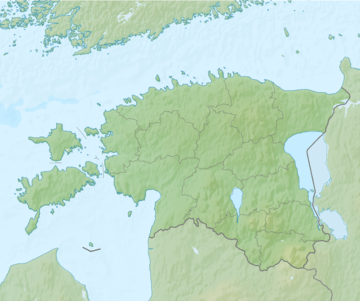 Tartu Location of Tartu in Estonia 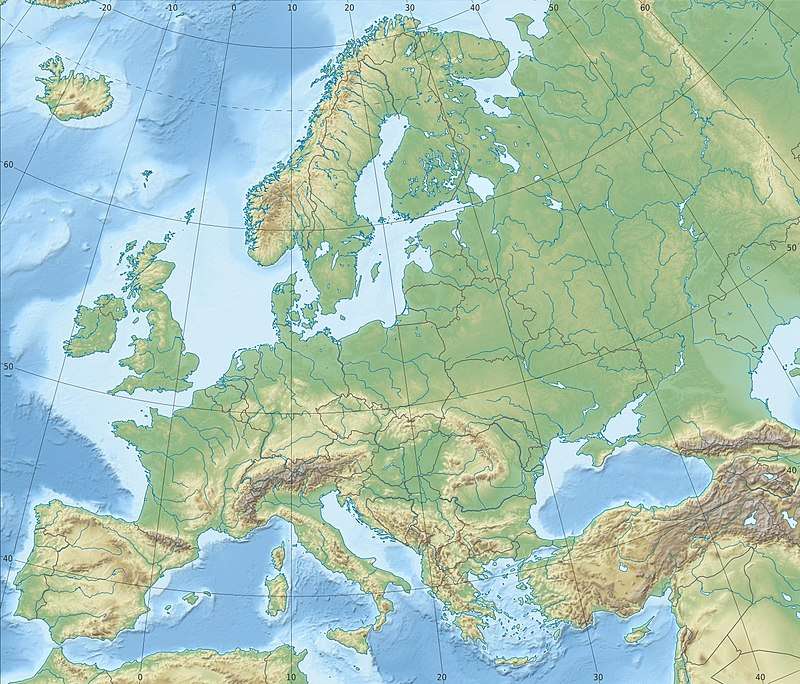 Tartu Tartu (Europe) | |||
| Coordinates: 58°23′N 26°43′E / 58.383°N 26.717°ECoordinates: 58°23′N 26°43′E / 58.383°N 26.717°E | |||
| Country |
| ||
| County |
| ||
| First settled | 5th century AD | ||
| First mentioned | 1030 | ||
| City rights | before 1262 | ||
| Named for | Taara or tarvas (Aurochs) | ||
| Government | |||
| • Mayor | Urmas Klaas (Reform Party) | ||
| Area | |||
| • Total | 38.80 km2 (15 sq mi) | ||
| • Land | 37.9 km2 (14.6 sq mi) | ||
| • Water | 1.3 km2 (0.5 sq mi) 3.39% | ||
| Elevation | 57.2 m (188 ft) | ||
| Highest elevation | 79 m (259 ft) | ||
| Population (2018)[1] | |||
| • Total | 99,429 | ||
| • Rank | 2nd | ||
| • Density | 2,508.6/km2 (6,497/sq mi) | ||
| Ethnicity | |||
| • Estonians | 80.1% | ||
| • Russians | 14.6% | ||
| • other | 5.3% | ||
| Time zone | UTC+2 (EET) | ||
| • Summer (DST) | UTC+3 (EEST) | ||
| Postal code | 50050 to 51111 | ||
| Vehicle registration | T | ||
| Website | tartu.ee | ||
Tartu (Estonian pronunciation: [ˈtɑrtˑu], South Estonian: Tarto) is the second largest city of Estonia, after Estonia's political and financial capital Tallinn.
Tartu is often considered the intellectual centre of the country,[2][3][4] especially since it is home to the nation's oldest and most renowned university, the University of Tartu. The city also houses the Supreme Court of Estonia, the Ministry of Education and Research, and the new building of the Estonian National Museum, opened to the public in October of 2016.
It is also the birthplace of Estonian Song Festivals.
Situated 186 kilometres (116 miles) southeast of Tallinn and 245 kilometres (152 miles) northeast of Riga, Tartu lies on the Emajõgi ("Mother river"), which connects the two largest lakes of Estonia. The city is served by Tartu Airport.
Names and etymology
Since 1918, the Estonian name Tartu has been used, but as the town has come under control of various rulers throughout its history, there have been various names for it in different languages. Most of them derive ultimately from the earliest attested form, the Estonian Tarbatu. In German, Swedish and Polish the town has been known and is sometimes still referred to as ![]()
History
Ugandi County pre-1030
![]()
Ugandi County 1061–1134
![]()
Ugandi County 1134–1191/1192
![]()
Ugandi County 1191/1192–1220
![]()
Ugandi County 1223
![]()
![]()
![]()
![]()
![]()
![]()
![]()
![]()
![]()
![]()
![]()
![]()
![]()
![]()
![]()
![]()
![]()
![]()
![]()
![]()
![]()
![]()
![]()
![]()
![]()
![]()
Beginnings
Archaeological evidence of the first permanent settlement on the site of modern Tartu dates to as early as the 5th century AD.[5][6] By the 7th century, local inhabitants had built a wooden fortification on the east side of Toome Hill (Toomemägi).[6]
The first documented record of the area was made in 1030 by chroniclers of Kievan Rus. Yaroslav I the Wise, Prince of Kiev, invaded the region that year, built his own fort there, and named it Yuryev[6][7] (literally "Yury's" – Yury (a Russified form of George) being Yaroslav's Christian name). Kievan rulers then collected tribute from the surrounding ancient Estonian county of Ugaunia, possibly until 1061, when, according to chronicles, Yuryev was burned down by Estonian tribe called Sosols.[8] Kievan Rus' again controlled Tartu from 1133 for an unknown period, possibly up to 1176/1177.[9] In the 12th century Tartu was the most notable Slavic settlement in Chud territory.[10]
Estonian amateur historian Enn Haabsaar speculates that the "Yuryev" mentioned in this context is actually Bila Tserkva, Ukraine, a town that was also founded by Yaroslav I the Wise as Yuriev about the same time, 1032.[11] His views have been criticized by historian Ain Mäesalu.[6]
Medieval bishopric

.jpg)
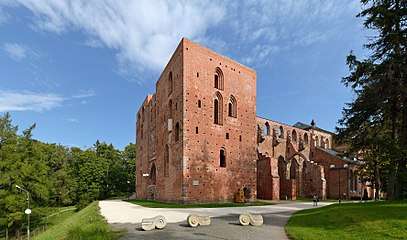
During the period of Northern Crusades in the beginning of the 13th century the fort of Tarbatu (or Tharbata, Tartu) was captured by the crusading Livonian Knights — also known as the Brothers of the Sword (German: Schwertbrüder) — and recaptured by Estonians on several occasions. In 1224, after Ugaunia had recognized the supremacy of Novgorod and Pskov princes who sent additional troops led by prince Vyachko of Kukenois to the fort, it was besieged and conquered for one last time by the German crusaders.[12] Subsequently, known as Dorpat (Latin: Tarbatum), Tartu became a commercial centre of considerable importance during the later Middle Ages and the capital of the semi-independent Bishopric of Dorpat.
In 1262 the army of Prince Dmitri of Pereslavl, son of Alexander Nevsky launched an assault on Dorpat, capturing and destroying the town. His troops did not manage to capture the bishop's fortress on Toome Hill. The event was recorded both in German and Old East Slavic chronicles, which also provided the first record of a settlement of German merchants and artisans which had arisen alongside the bishop's fortress.
In medieval times, after the Livonian Order was subsumed into the Teutonic Knights in 1236, the town became an important trading city. In the 1280s Dorpat joined the Hanseatic League. As in all of Estonia and Latvia, the largely German-speaking nobility, but in Tartu/Dorpat (as in Tallinn) even more so, the Baltic German bourgeoisie, the literati, dominated culture, religion, architecture, education, and politics until the late 19th century. For example, the town hall of Dorpat was designed by an architect from Rostock in Mecklenburg, while the university buildings were designed by Johann Wilhelm Krause, another German. Many, if not most, of the students, and more than 90 percent of the faculty members were of German descent, and numerous statues of notable scholars with German names can still be found in Tartu today. Most Germans left during the first half of the 20th century, in particular as part of the Heim ins Reich program of the Nazis, following the Molotov–Ribbentrop Pact in 1939.
Swedish and Polish rule
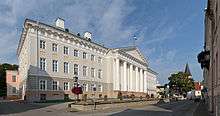
In 1558, tsar Ivan the Terrible invaded Tartu beginning the Livonian War. Forces under the command of Pyotr Shuiski encircled the town and began heavy bombardment. In light of this and without any prospect of external help the town surrended. The local bishop was imprisoned in Moscow, which effectively ended the period of local self-government. In the effect of the Truce of Jam Zapolski of 1582 the city along with southern regions of Livonian Confederation became part of the Polish–Lithuanian Commonwealth. In 1598 it became the capital of the Dorpat Voivodeship of the Duchy of Livonia. A Jesuit grammar school "Gymnasium Dorpatense" was established in 1583. In addition, a translators' seminary was organized in Tartu and the city received its red and white flag from the Polish king Stephen Báthory.
The activities of both the grammar school and the seminary were stopped by the Polish–Swedish War. Already in late 1600 the forces of Charles IX of Sweden besieged the city defended by three banners of reiters and the city's burghers. Despite repeated assaults, the Swedes could not enter the city. Finally in 1601 Capt. Hermann Wrangel switched sides, assaulted the castellan and opened the gates for the Swedish forces. The town was retaken by Poland on 13 April 1603 following a brief siege led by hetman Jan Karol Chodkiewicz; roughly 1000 Swedish soldiers surrendered and were escorted to Tallinn.
In the effect of yet another Polish-Swedish War, in 1625 Tartu was once again captured by Sweden, this time for good. In the effect of the 1629 Truce of Altmark the city became part of the Dominions of Sweden, which led to the foundation of the University of Tartu in 1632 by king Gustavus Adolphus of Sweden.
Imperial Russia
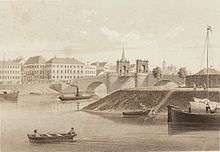
1704 the town was taken by Russian army in the presence of tsar Peter the Great himself. As a result around a quarter of the town and much of the fortifications were damaged. In 1708 the remainder of the fortifications and houses, including the remains of bishops castle, were blown up, all movable property was looted and all citizens deported to Russia. With the Treaty of Nystad in 1721, the city became part of the Russian Empire and was known as Derpt. Fires in the 18th century destroyed much of the medieval architecture, the Great Fire of Tartu in 1775 removed most of the buildings in the centre. The city was rebuilt along Late Baroque and Neoclassical lines including the Tartu Town Hall which was built between 1782 and 1789.[13]
During the second half of the 19th century, Tartu was the cultural centre for Estonians in the era of Romantic nationalism. The city hosted Estonia's first song festival in 1869. Vanemuine, the first national theatre, was established in 1870. Tartu was also the setting for the foundation of the Society of Estonian Writers in 1872.
Tartu railway station was opened in 1876 when Tapa–Tartu route was built. The station building was opened in 1877.
In 1893, the city was officially retitled to the ancient Russian name Yuryev. The university was subsequently russified from 1895 on with the introduction of compulsory Russian in teaching. Much of the university property was relocated to Voronezh in 1918 and during the German occupation the University worked under the name Landesuniversität Dorpat. During the Estonian War of Independence university of Tartu was re-opened as an Estonian language university on 1 December 1919.
First independence period
With Estonian independence after World War I, the city officially became known by the Estonian name Tartu. At the end of Estonian War of Independence following World War I, a peace treaty between the Bolsheviks and Estonia was signed on 2 February 1920 in Tartu (Treaty of Tartu). The treaty meant that Soviet Russia renounced territorial claims to Estonia "for all time". However, as a result of the Nazi-Soviet Pact of 1939, the Soviet Union occupied Estonia and Tartu in 1940.
Peace treaty between Soviet Russia and Finland was also signed in Tartu in 1920.
During the interwar period Tähtvere neighbourhood was built, former Raadi Manor buildings started to house Estonian National Museum (destroyed during Tartu Offensive in 1944) and art school Pallas was opened.
Soviet period
During World War II, a large part of the city as well as the historical Kivisild (Stone Bridge) (built by Catherine II of Russia in 1776–1778) over the Emajõgi river were destroyed by the retreating Soviet Army, partly in 1941 and almost completely in 1944 by then retreating German Army. Already heavily damaged Tartu was bombed by Soviet forces on 27 January 1943, 26 February 1944, 7–8 March 1944, and 25–26 March 1944. After the war ended, much of the historical downtown area was left in ruins. Even the less damaged buildings in entire city blocks were torn down by the order of the occupational authorities and large swaths of land turned into public parks.
After the war, Tartu was declared a "closed town" to foreigners, as an air base for bombers was constructed on Raadi Airfield, in the northeast outskirts of the city. It was one of the biggest military air bases in Eastern Europe and housed intercontinental fighters, that carried nuclear bombs. The location itself was where the Estonian 2nd Air Division was situated prior to the Soviet occupation. The asphalt runway there now houses a large used cars market, and is sometimes used for automotive racing.
Tartu Airport was opened in south of city in 1946. Besides the airport Estonian Aviation Academy was established in 1993 and Estonian Aviation Museum was opened to the public in 2002. During Soviet times the population of Tartu almost doubled from 57,000 to 100,000, partly due to mass immigration from other areas of the Soviet Union.

Modern era
Since Estonia regained its independence in 1991, the old town centre is being renovated. Notably, St. John's Church, in ruins since World War II, has been restored.
Many new commercial and business buildings have been erected (Tartu Shopping Center, Tasku, Emajõe Commercial Center, Lõunakeskus, Kvartal etc.). Highest residential building and local landmark Tigutorn was opened in 2008.
Science center AHHAA relocated to a new building in 2011 and Estonian National Museum, the new main building was opened in 2016.
Geography
Climate
Tartu lies within the temperate humid continental climate zone. The climate is rather mild considering the high latitude, largely due to the proximity of the Baltic Sea and warm airflows from the Atlantic. Nevertheless, continental influence can be felt on hot summer days and cold spells in winter, when temperature can occasionally (but rarely) drop below −30 °C (−22 °F). Generally, summers are cool to warm and winters are cold.
| Climate data for Tartu (Tõravere) 1981–2010 | |||||||||||||
|---|---|---|---|---|---|---|---|---|---|---|---|---|---|
| Month | Jan | Feb | Mar | Apr | May | Jun | Jul | Aug | Sep | Oct | Nov | Dec | Year |
| Record high °C (°F) | 9.7 (49.5) |
10.4 (50.7) |
18.4 (65.1) |
27.3 (81.1) |
30.1 (86.2) |
31.1 (88) |
34.2 (93.6) |
35.1 (95.2) |
30.2 (86.4) |
21.5 (70.7) |
13.6 (56.5) |
12.5 (54.5) |
35.1 (95.2) |
| Average high °C (°F) | −2.1 (28.2) |
−2.2 (28) |
2.7 (36.9) |
10.6 (51.1) |
17.0 (62.6) |
20.1 (68.2) |
22.7 (72.9) |
21.2 (70.2) |
15.4 (59.7) |
9.2 (48.6) |
2.5 (36.5) |
−1 (30) |
9.7 (49.5) |
| Daily mean °C (°F) | −4.6 (23.7) |
−5.3 (22.5) |
−1.0 (30.2) |
5.5 (41.9) |
11.5 (52.7) |
15.0 (59) |
17.6 (63.7) |
16.2 (61.2) |
11.0 (51.8) |
6.1 (43) |
0.3 (32.5) |
−3.3 (26.1) |
5.8 (42.4) |
| Average low °C (°F) | −7.1 (19.2) |
−8.2 (17.2) |
−4.3 (24.3) |
1.1 (34) |
6.0 (42.8) |
9.7 (49.5) |
12.5 (54.5) |
11.7 (53.1) |
7.4 (45.3) |
3.5 (38.3) |
−1.5 (29.3) |
−5.6 (21.9) |
2.1 (35.8) |
| Record low °C (°F) | −35.4 (−31.7) |
−35.8 (−32.4) |
−25.9 (−14.6) |
−11.4 (11.5) |
−5.9 (21.4) |
0.1 (32.2) |
3.1 (37.6) |
2.0 (35.6) |
−4.3 (24.3) |
−13.8 (7.2) |
−20.8 (−5.4) |
−32.2 (−26) |
−35.8 (−32.4) |
| Average precipitation mm (inches) | 48 (1.89) |
35 (1.38) |
28 (1.1) |
30 (1.18) |
55 (2.17) |
84 (3.31) |
72 (2.83) |
86 (3.39) |
61 (2.4) |
69 (2.72) |
53 (2.09) |
49 (1.93) |
680 (26.77) |
| Average relative humidity (%) | 88 | 85 | 79 | 69 | 66 | 72 | 74 | 78 | 83 | 86 | 89 | 89 | 80 |
| Mean monthly sunshine hours | 31.5 | 63.6 | 127.3 | 183.3 | 257.0 | 251.1 | 268.6 | 219.9 | 135.8 | 81.5 | 31.3 | 24.3 | 1,675.8 |
| Source: Estonian Weather Service[14][15][16][17] | |||||||||||||
Government
There are 49 members on the town council, elected by residents every four years using a proportional system of representation.[18]
The executive branch of the town government consists of a mayor and five deputy mayors.[19] The current mayor is Urmas Klaas. Andrus Ansip, Prime Minister of Estonia from 2005 to 2014, was mayor of Tartu from 1998 to 2004. The position was later served by other politicians who eventually became ministers of government, Laine Jänes and Urmas Kruuse. All of them are members of the Estonian Reform Party, which has dominated in Tartu since 1998.
Economy
Mostly known as a university town, Tartu is also a site of heavy industry. The food industry has traditionally been important for the town's economy and some bigger companies in the field include A. Le Coq, Tartu Mill and Salvest. Kroonpress is the leading printing press company the Baltic States.
In the beginning of the 21st century, many ICT enterprises and other high-tech companies have taken a foothold in Tartu. Notable examples include Playtech Estonia, Nortal (formerly Webmedia Group), ZeroTurnaround, Tarkon, Reach-U and Raintree Estonia. Skype has an office in Tartu. The university is one of the largest employers, which explains the large proportion of highly skilled professionals – researchers, professors, doctors, and Tartu University Clinic has been considered the largest employer of Tartu.
Population
| Ethnic group |
Statistics 2017[1] | |
|---|---|---|
| Number | % | |
| Estonians | 74,396 | 79.9% |
| Russians | 13,543 | 14.5% |
| Ukrainians | 957 | 1.0% |
| Finns | 856 | 0.9% |
| Belarusians | 335 | 0.4% |
| Germans | 280 | 0.3% |
| Latvians | 198 | 0.2% |
| Poles | 109 | 0.1% |
| Lithuanians | 109 | 0.1% |
| Other/Unknown | 2,341 | 2.6% |
| Total | 93,124 | 100% |
| Year | 1881 | 1897 | 1922 | 1934 | 1959 | 1970 | 1979 | 1989 | 1995 | 2000 | 2005 | 2010 | 2015 | 2016 |
|---|---|---|---|---|---|---|---|---|---|---|---|---|---|---|
| Population | 29,974 | 42,308 | 50,342 | 58,876 | 74,263 | 90,459 | 104,381 | 113,320 | 104,874 | 101,241 | 101,483 | 103,284 | 97,332 | 93,687 |
Tartu's historic population is presented in the following table, based on data from official censuses since 1881[20] and Estonian Statistical Office.[21] Note that the data up to 2011 is not directly comparable to the most recent numbers, as the methodology of compiling population statistics has changed.[22]
Neighbourhoods
Tartu is officially divided into 17 neighbourhoods, which carry no administrative purposes. Their names and borders are defined.

| Neighborhood | Area (ha) | Residents 2001 | Residents 2006 | Residents 2012 |
|---|---|---|---|---|
| Annelinn | 541 | 30,000 | 28,200 | 27,480 |
| Ihaste | 424 | 1,000 | 1,800 | 2,322 |
| Jaamamõisa | 149 | 3,000 | 3,000 | 3,202 |
| Karlova | 230 | 9,500 | 9,000 | 9,073 |
| Kesklinn | 180 | 7,500 | 6,700 | 6,575 |
| Maarjamõisa | 113 | 800 | 500 | 377 |
| Raadi-Kruusamäe | 283 | 5,000 | 4,800 | 4,626 |
| Ropka | 146 | 5,500 | 5,300 | 5,120 |
| Ropka industrial district | 354 | 2,700 | 2,700 | 2,511 |
| Ränilinn | 122 | 2,500 | 1,800 | 1,732 |
| Supilinn | 48 | 2,100 | 1,800 | 1,790 |
| Tammelinn | 311 | 8,000 | 8,100 | 8,195 |
| Tähtvere | 250 | 4,500 | 3,500 | 3,023 |
| Vaksali | 75 | 2,900 | 3,100 | 3,206 |
| Variku | 77 | 2,000 | 1,900 | 1,840 |
| Veeriku | 281 | 5,500 | 5,300 | 5,561 |
| Ülejõe | 302 | 8,200 | 7,700 | 7,876 |
.jpg)
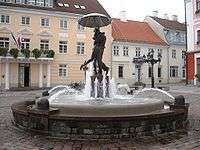
Education and culture
The city is best known for being home to the University of Tartu, founded under King Gustavus Adolphus of Sweden in 1632. Mainly for this reason, Tartu is also – tongue-in-cheek – known as "Athens of the Emajõgi" or as "Heidelberg of the North".
Tartu is also the seat of the Estonian University of Life Sciences, the Baltic Defence College, Estonian Aviation Academy (formerly known as Tartu Aviation College), and the Estonian Ministry of Education and Research. Other notable institutions include the Supreme Court of Estonia (re-established in Tartu in autumn 1993), the Estonian Historical Archives, Estonian National Museum, Estonian Sports Museum as well as the oldest and renowned theatre in the country, Vanemuine, where they have a well-respected ballet company as well as theatre, opera and musical productions.
In music, there exists the Tartu school of composition.
Most of the sculptures in Tartu are dedicated to historical figures. Among them the most famous are the Barclay de Tolly monument on the Barclay Square in downtown, the Kissing students monument on the town hall square and Gustav II Adolf´s monument on the Kuningaplats.
Science
Tartu has been an intellectual centre of both Estonia and Baltic countries for several centuries. Scholars hailing from Tartu include the pioneer of embryology Karl Ernst von Baer, a pioneer of animal behaviour studies Jakob von Uexküll, and a cultural theorist and semiotician Juri Lotman. Nobel Chemistry Prize laureate Wilhelm Ostwald studied and worked in Tartu. Tartu School is one of the leading scientific schools in the field of semiotics.
Main sights
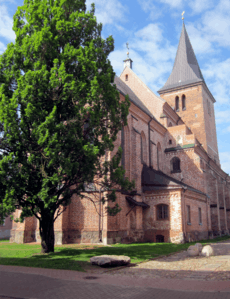

The architecture and city planning of historical Tartu mainly go back to the pre-independence period, with Germans forming the upper and middle classes of society, and therefore contributing many architects, professors and local politicians.
Most notable are the old Lutheran St. John's Church (Estonian: Jaani Kirik, German: Johanneskirche), the 18th-century town hall, the university building, ruins of the 13th-century cathedral, the botanical gardens, the main shopping street, many buildings around the town hall square and Barclay Square.
The historical slum area called Supilinn (Soup Town) is located on the bank of river Emajõgi, near the town centre and is regarded as one of the few surviving "poor" neighbourhoods of 19th-century Europe. At the moment Supilinn is being rapidly renovated, undergoing a slow transformation from the historic slum into a prestigious high-class neighborhood. The active community embodied by the Supilinn Society is committed to preserving the heritage.
The Second World War destroyed large parts of the city centre and during the Soviet occupation many new buildings were erected – notably the new Vanemuine Theater. The effects of the war are still witnessed by the relative abundance of parks and greenery in the historic centre. Typical Soviet-style neighbourhoods of blocks of high-rise flats were built between World War II and the restoration of Estonian independence in 1991, the largest such district being Annelinn.
Presently, Tartu is also known for several modern buildings of the "steel, concrete and glass" variation, but has managed to retain a mix of old and new buildings in the centre of town. Notable examples include the Tigutorn Tower and the Emajõe Centre, both built during the current period of independence; Tartu's tallest and second tallest towers, respectively. Tartu's large student population means that it has a comparatively thriving nightlife, with many nightclubs, bars, and restaurants, including the world's highest-ceiling pub, in the historic Gunpowder Cellar of Tartu.
Annually, in the summer, Tartu hosts the Hanseatic Days festival (Estonian: Hansapäevad) to celebrate its Hanseatic heritage. The festival includes events such as handicraft markets, historic workshops and jousting tournaments.
Sports
Tartu is the home for basketball club Tartu Ülikool/Rock, which is participating in the Korvpalli Meistriliiga, the Baltic Basketball League and the EuroChallenge.
Football club JK Tammeka Tartu, one of the Meistriliiga clubs, is located in Tartu. Their home stadium is the Tamme Staadion, which has a capacity of 1 600 people. The city is also home to the Tartu JK Welco and FC Santos Tartu clubs, which play in the Esiliiga, the second division.
There is a professional handball team, the Tartu Ülikool/Glassdrive, which plays in the second division of Estonian handball.
Tartu is the hometown of the BIGBANK Tartu volleyball club.
Tartu is also the hometown of Clement "Puppey" Ivanov, captain of Team Secret, a professional Dota 2 team. He won the first International, and was runner-up two years in a row with Natus Vincere.[23]
The 2017 World Orienteering Championships were held in Tartu.[24]
The annual running event Tartu Sügisjooks takes place in Tartu.
Notable people
- Lauri Aus (1970–2003), professional road cyclist
- George Browne, (1698-1792), Irish-born Governor of Tartu
- Elisabeth Erm (1993), fashion model
- George Hackenschmidt (1877–1968), strongman, professional wrestler, writer and philosopher.
- Leonid Kulik (1883–1942), Russian mineralogist
- Karl Linnas (1919–1987), Nazi concentration camp commandant
- Emil Mattiesen (1875–1939), composer, pianist and philosopher
- Rein Taaramäe (1987), professional road cyclist
- Kristina Šmigun-Vähi (1977), cross-country skier
- Carl Robert Jakobson (1841-1882), writer, politician and teacher
- Laura Põldvere (1988), singer
- Andrus Ansip (1956), politician, former Prime Minister of Estonia
- Eno Raud (1928-1996), children's author
- Rasmus Kaljujärv (1981), actor
International relations
Twin towns – Sister cities
|
Gallery
- University of Tartu main building
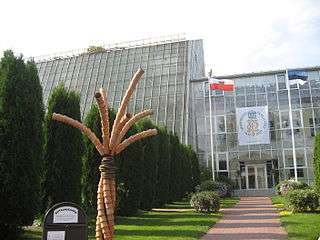
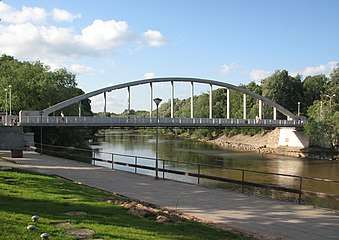 Arch pedestrian bridge over the Emajõgi
Arch pedestrian bridge over the Emajõgi Cathedral ruins and University of Tartu museum
Cathedral ruins and University of Tartu museum Teller chapel in Tartu, Estonia. Built in 1794
Teller chapel in Tartu, Estonia. Built in 1794- Tartu Art Museum
- Song Festival Museum
- "Little House" of the Vanemuine theater
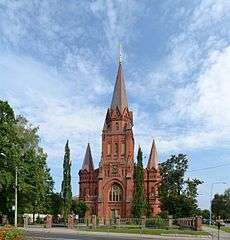 St. Peter's Church
St. Peter's Church
See also
References
- 1 2 "Eesti elanike arv KOV" (PDF).
- ↑ Tartu – the intellectual centre of Estonia estlandia.de
- ↑ Jonathan Bousfield The Rough Guide to Estonia, Latvia & Lithuania. Rough Guides UK. Page 126
- ↑ Sergey Chernov. Tartu: Estonia's Intellectual and Theater Capital The Moscow Times, Dec. 24 2012
- ↑ "Tartu". Encyclopædia Britannica. Retrieved 26 January 2013.
- 1 2 3 4 Mäesalu, Ain (12 October 2001). "Vene kroonikate Jurjev oli tõenäoliselt siiski Tartu" (in Estonian). Sirp. Retrieved 26 January 2013.
- ↑ Tvauri, Andres (2012). The Migration Period, Pre-Viking Age, and Viking Age in Estonia. pp. 33, 59, 60. Retrieved 27 December 2016.
- ↑ Mäesalu, Ain (2012). "Could Kedipiv in East-Slavonic Chronicles be Keava hill fort?" (PDF). Estonian Journal of Archaeology. 1: 199. Retrieved 27 December 2016.
- ↑ Freymuth, Otto (1927). "Tartu orduajal" (in Estonian). Retrieved 26 January 2013.
- ↑ Юрьев уездный город Лифляндской губернии (in Russian). Dic.academic.ru. 14 March 1957. Retrieved 6 May 2009.
- ↑ Haabsaar, E. Kas Vene kroonikate Jurjev oli tõepoolest Tartu? Sirp, 21.09.2001. Archived 13 July 2007 at the Wayback Machine.
- ↑ Anti Selart, Ivar Leimus, Linda Kaljundi, Heiki Valk. Ristiretked ja vallutussõjad 13. sajandi Liivimaal, in "Eesti ajalugu II. Eesti keskaeg." Editor Anti Selart. Tartu 2012. Pp. 52—53
- ↑ The Town Hall of Tartu, tartu.ee, retrieved 27 December 2013
- ↑ "Climate normals-Temperature". Estonian Weather Service. Retrieved 24 September 2016.
- ↑ "Climate normals-Precipitation". Estonian Weather Service. Retrieved 24 September 2016.
- ↑ "Climate normals-Humidity". Estonian Weather Service. Retrieved 24 September 2016.
- ↑ "Climate normals-Sunshine". Estonian Weather Service. Retrieved 24 September 2016.
- ↑ "Tartu Linnavolikogu liikmete nimekiri". Tartu.ee. 17 November 2009. Retrieved 21 November 2010.
- ↑ "Linnavalitsuse koosseis". Tartu.ee. 15 June 2010. Retrieved 21 November 2010.
- ↑ "General data for 1881, 1897, 1922, 1934, 1959, 1970, 1979, 1989 censuses - Statistics Estonia". www.stat.ee.
- ↑ "Population by sex, age group and county, 1 January". Statistics Estonia. 16 March 2012. Retrieved 19 February 2014.
- ↑ "Definitions and Methodology". pub.stat.ee.
- ↑ "International Teams". Valve Corporation. Retrieved 20 Jul 2014.
- ↑ "Nokian Tyres World Orienteering Championships 2017". www.woc2017.ee.
- ↑ "Tartu sõpruslinnad" (in Estonian). Tartu. Retrieved 1 May 2012.
- ↑ "Frederiksberg Municipality – Twin Towns" (in Danish). [[copyright|]]2007 -2009 Frederiksberg Municipality. Archived from the original on 15 June 2011. Retrieved 9 September 2009. External link in
|publisher=(help) - ↑ "Tartu arendab suhteid Armeenia linna Gümriga" (in Estonian). Äripäev. 16 November 2004. Archived from the original on 26 February 2014. Retrieved 30 May 2012.
External links
| Wikimedia Commons has media related to Tartu. |
| Wikivoyage has a travel guide for Tartu. |

